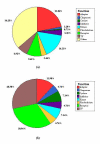SigFlux: a novel network feature to evaluate the importance of proteins in signal transduction networks
- PMID: 17129367
- PMCID: PMC1683949
- DOI: 10.1186/1471-2105-7-515
SigFlux: a novel network feature to evaluate the importance of proteins in signal transduction networks
Abstract
Background: Measuring each protein's importance in signaling networks helps to identify the crucial proteins in a cellular process, find the fragile portion of the biology system and further assist for disease therapy. However, there are relatively few methods to evaluate the importance of proteins in signaling networks.
Results: We developed a novel network feature to evaluate the importance of proteins in signal transduction networks, that we call SigFlux, based on the concept of minimal path sets (MPSs). An MPS is a minimal set of nodes that can perform the signal propagation from ligands to target genes or feedback loops. We define SigFlux as the number of MPSs in which each protein is involved. We applied this network feature to the large signal transduction network in the hippocampal CA1 neuron of mice. Significant correlations were simultaneously observed between SigFlux and both the essentiality and evolutionary rate of genes. Compared with another commonly used network feature, connectivity, SigFlux has similar or better ability as connectivity to reflect a protein's essentiality. Further classification according to protein function demonstrates that high SigFlux, low connectivity proteins are abundant in receptors and transcriptional factors, indicating that SigFlux candescribe the importance of proteins within the context of the entire network.
Conclusion: SigFlux is a useful network feature in signal transduction networks that allows the prediction of the essentiality and conservation of proteins. With this novel network feature, proteins that participate in more pathways or feedback loops within a signaling network are proved far more likely to be essential and conserved during evolution than their counterparts.
Figures





Similar articles
-
Investigations into the relationship between feedback loops and functional importance of a signal transduction network based on Boolean network modeling.BMC Bioinformatics. 2007 Oct 15;8:384. doi: 10.1186/1471-2105-8-384. BMC Bioinformatics. 2007. PMID: 17935633 Free PMC article.
-
Transcriptional feedbacks in mammalian signal transduction pathways facilitate rapid and reliable protein induction.Mol Biosyst. 2010 Jul;6(7):1277-84. doi: 10.1039/c002598d. Epub 2010 May 7. Mol Biosyst. 2010. PMID: 20449523
-
A protein interaction atlas for the nuclear receptors: properties and quality of a hub-based dimerisation network.BMC Syst Biol. 2007 Jul 31;1:34. doi: 10.1186/1752-0509-1-34. BMC Syst Biol. 2007. PMID: 17672894 Free PMC article.
-
Biological Network Inference and analysis using SEBINI and CABIN.Methods Mol Biol. 2009;541:551-76. doi: 10.1007/978-1-59745-243-4_24. Methods Mol Biol. 2009. PMID: 19381531 Review.
-
Genomic analysis of essentiality within protein networks.Trends Genet. 2004 Jun;20(6):227-31. doi: 10.1016/j.tig.2004.04.008. Trends Genet. 2004. PMID: 15145574 Review.
Cited by
-
Investigations into the relationship between feedback loops and functional importance of a signal transduction network based on Boolean network modeling.BMC Bioinformatics. 2007 Oct 15;8:384. doi: 10.1186/1471-2105-8-384. BMC Bioinformatics. 2007. PMID: 17935633 Free PMC article.
-
Elementary signaling modes predict the essentiality of signal transduction network components.BMC Syst Biol. 2011 Mar 22;5:44. doi: 10.1186/1752-0509-5-44. BMC Syst Biol. 2011. PMID: 21426566 Free PMC article.
-
Bioinformatics in China: a personal perspective.PLoS Comput Biol. 2008 Apr 25;4(4):e1000020. doi: 10.1371/journal.pcbi.1000020. PLoS Comput Biol. 2008. PMID: 18437216 Free PMC article. Review. No abstract available.
-
Exploring the multifactorial nature of autism through computational systems biology: calcium and the Rho GTPase RAC1 under the spotlight.Neuromolecular Med. 2013 Jun;15(2):364-83. doi: 10.1007/s12017-013-8224-3. Epub 2013 Mar 2. Neuromolecular Med. 2013. PMID: 23456597
References
Publication types
MeSH terms
Substances
LinkOut - more resources
Full Text Sources
Other Literature Sources
Miscellaneous

